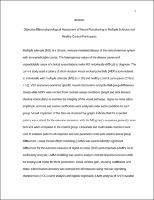Please use this identifier to cite or link to this item:
https://hdl.handle.net/20.500.12202/6206| Title: | Objective Electrophysiological Assessment of Neural Functioning in Multiple Sclerosis and Healthy Control Participants |
| Authors: | Foley, Frederick W. Zemon, Vance Gordon, James Archetti, Roseann Nicole |
| Keywords: | physiological psychology psychobiology multiple sclerosis Visual Evoked Potentials paraclinical diagnostic tools |
| Issue Date: | Aug-2020 |
| Citation: | Archetti, Roseann. (2020). Objective Electrophysiological Assessment of Neural Functioning in Multiple Sclerosis and Healthy Control Participants. [Unpublished doctoral dissertation, Yeshiva University] |
| Abstract: | Multiple sclerosis (MS) is a chronic, immune-mediated disease of the central nervous system with an unpredictable course. The heterogenous nature of the disease course and unpredictable nature of clinical exacerbations make MS notoriously difficult to diagnose. The current study used a battery of short-duration visual evoked potentials (VEPs) administered to individuals with multiple sclerosis (MS) (n = 20) and healthy control participants (CN) (n = 18). VEP responses examined specific neural mechanisms and potential group differences. Steady-state VEPs were elicited from contrast-sweep conditions (bright and dark isolated checks) monocularly to examine the integrity of the visual pathways. Signal-to-noise ratios, amplitude, and sine and cosine coefficients were analyzed under each condition for each group. Visual inspection of the data via clustered bar graphs indicate that the expected pattern was evident for the outcome measures, with the MS group’s responses generally more deficient when compared to the control group. Univariate and multivariate statistics were used to examine patterns of responses and non-parametric tests were used to assess group differences. Linear mixed effects modeling (LMM) was used to identify significant differences for the outcome measures of signal-to-noise (SNR) and amplitude (AMP). In an exploratory analysis, LMM modeling was used to analyze contrast-response functions with the biophysical model for three parameters: initial contrast gain, shunting coefficient, and phase. Classification accuracy was assessed for all measures using receiver-operating-characteristic (ROC) curve analysis and logistic regression. LMM analysis of SNR revealed significant differences for the fixed effects of depth of modulation (log2DOM) (Δ-2LL = 296.343, df = 1, p < .01), Group x Log2DOM interaction (Δ-2LL = 7.463, df = 1, p < .01), and test condition (bright versus dark checks) (Δ-2LL = 37.579, df = 1, p < .01). Similarly, LMM analysis of amplitude revealed significant differences for the fixed effects of log2DOM (Δ-2LL = 323.031, df = 1, p < .01), Group x Log2DOM interaction (Δ-2LL = 18.917, df = 1, p < .01), test condition (bright versus dark checks) (Δ-2LL = 31.022, df = 1, p < .01), and Test x Log2DOM interaction effect (Δ-2LL = 8.939, df = 1, p < .01). LMM analysis of initial contrast gain revealed a significant difference for the fixed effect of test condition (bright versus dark checks) (Δ-2LL = 9.732, df = 1, p < .01). Similarly, LMM analysis of phase also revealed a significant difference for the fixed effect of test condition (Δ-2LL = 7.642, df = 1, p < .01). A final LMM analysis for the shunting coefficient revealed a significant difference for the main effect of group (Δ-2LL = 4.906, df = 1, p < .05). An assessment for heterogeneity of regression coefficients for the sine versus cosine coefficients of the fundamental frequency component of the response (at the stimulus frequency of 10 Hz) revealed a significant interaction effect for the bright check condition, Group x Cosine Coefficient (F (2, 72) = 23.14, p < .001). For the dark check condition, there was also a significant interaction effect of Group x Cosine Coefficient (F (2, 72) = 26.05, p < .001). ROC curve analysis and logistic regression revealed moderate predictive accuracy for classification of individuals with MS and healthy controls. The current study findings support the use of bright and dark isolated-check VEP conditions in the assessment of neuronal dysfunction in patients with MS. While this study is small, the significant differences identified between the MS and control populations justify continued research utilizing these novel VEP techniques as a paraclinical tool in the diagnosis and assessment of neuronal dysfunction in individuals with multiple sclerosis. |
| Description: | Dissertation, PhD., Ferkauf Graduate School of Psychology. Open Access. |
| URI: | https://hdl.handle.net/20.500.12202/6206 |
| Appears in Collections: | Ferkauf Graduate School of Psychology: Doctoral Dissertations |
Files in This Item:
| File | Description | Size | Format | |
|---|---|---|---|---|
| Archetti_Dissertation_FINAL optimized.pdf | 888.83 kB | Adobe PDF |  View/Open |
This item is licensed under a Creative Commons License

